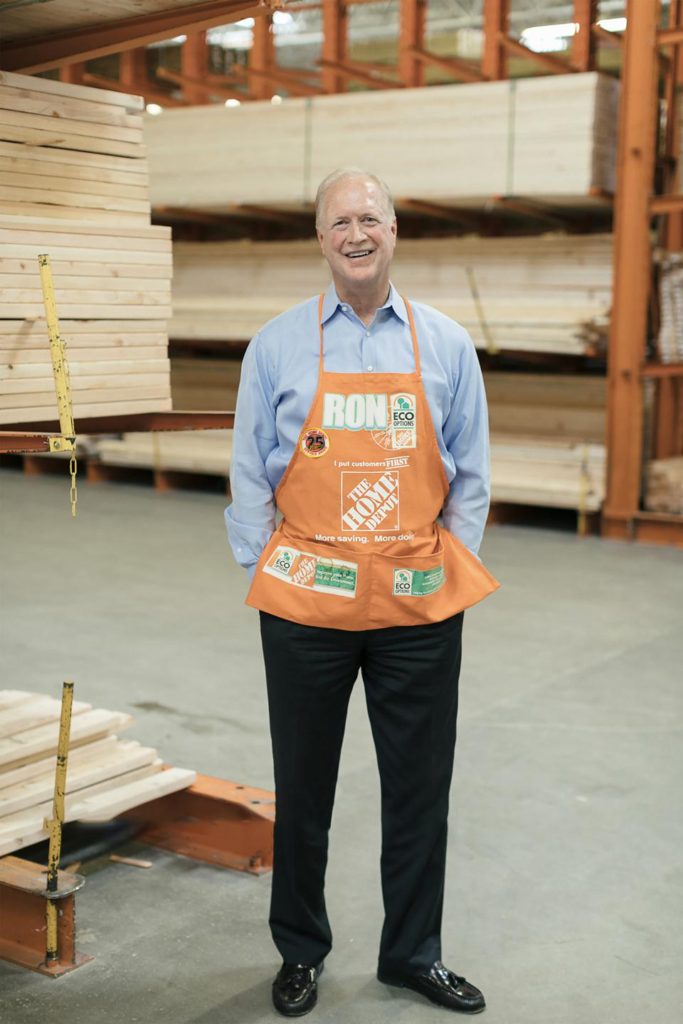
Brands that are transparent, accountable and proactive about purpose strengthen stakeholder relationships. Once you take the plunge into corporate social responsibility, it can be difficult to clarify, quantify and amplify your impact.
Home Depot is an excellent example of a brand leveraging business for the greater good. In the newly released Home Depot 2020 Responsibility Report, the company illustrates its environmental and social responsibility. Some highlights include a 10% reduction in CO2 emissions since last year and a $1 billion COVID-19 relief investment for employees. Also of note, Home Depot committed to phasing out expanded polystyrene (EPS) foam and polyvinyl chloride (PVC) film from its proprietary brand packaging by 2023. The brand also vouched to make or purchase 335 megawatts of renewable energy (enough to power over 90,000 homes for a year) by 2025.
I had the pleasure of speaking with Ron Jarvis, Home Depot’s VP of Merchandising and Sustainability, about how America’s largest home improvement store leads with purpose. Here’s what we discussed:
Simon Mainwaring: Ron, you’ve been working at Home Depot 25 years. Tell us about your role today.
Ron Jarvis: One of my titles is Chief Sustainability Officer. I oversee several business functions in our group. There’s sustainability and responsible sourcing. That includes factory audits overseas to ensure social and environmental compliances. We also handle product safety and utility rebates.
SM: Based on your new sustainability report, what are you doing to reengineer your supply chain?
RJ: In 1993, we were the first retailer to announce a check and balance systems for environmental claims. If a manufacturer made an environmental benefit claim, they had to bring verification. No one was doing that back then. We were the first national retailer to have certified wood from the Forest Stewardship Council (FSC) in our stores.

When you start talking about environmental concerns, people either get very excited about one specific issue or they get glassy-eyed because there’s a thousand points of information coming at them. We were able to break all that down into five categories. 99.9% of environmental impact falls into these five categories: carbon emissions, chemical exposure, deforestation, water conservation and waste.
We use those categories to keep a good grasp on what our environmental impact is. We use the Responsibility Report like a report card.
SM: How do you make sure suppliers are aligned with what you’re trying to achieve?
RJ: When we first rolled out Eco Options, we spent hundreds of thousands of dollars training our associates. We taught them how to talk about certified wood and answer other sustainability questions consumers might have. Six months later, they came back and said, ‘Nobody asked me anything.’ We realized many consumers wanted to do their own research. So, we pushed certification.
We mandated everything that comes into the Eco Options program should be certified or verified. A few years ago, I noticed something. We do $10 billion in Eco Options. It’s about 10% of our sales. I’d walk past 90% of our product categories to talk about the 10%. What about the other 90%?
We started concentrating on the big categories that we know are not going to be in Eco Options. We have one of the most comprehensive chemical policies. We apply it to essentials like paint, carpet and insulation. They’re not going to be environmentally friendly, but we reduced their impact. Not everyone wants to be a green consumer. Sometimes we have to ‘green’ the product because it’s the right thing to do.
SM: How do you leverage your brick and mortar presence around the country for sustainability?
RJ: We don’t pick one market like Austin or Portland, and say, ‘We’re going to have a wider selection of eco-friendly or organics in those markets.’ We’re taking it into all markets.
SM: You do a lot of work that others may not be aware of in terms of veterans. Why is that?
RJ: We found many years ago that the veterans were underserved. So many come back from service and face issues around shelter. We saw that as a great place for us to step in and help.
SM: When the pandemic hit, what was your response?

RJ: When COVID-19 hit, every single decision we made focused on two priorities: the safety of our customers and associates and being open and available for our communities to get the essential items they need.
To promote a safe environment for associates and customers, we implemented a number of operational changes starting in mid-March. We adjusted our store hours, closing earlier than usual to give our associates more time to clean, sanitize and re-stock. We took a proactive and early stance on limiting customer traffic in our stores to better maintain physical and social distancing, and we cancelled major promotional events to avoid driving foot traffic to stores. We’ve recently announced that shoppers must wear a mask in our stores.
To take care of our hourly associates, we introduced weekly bonuses and expanded paid time off, which can be used at their discretion and will be paid out at year-end if unused. We are also offering additional paid time off for associates who are 65 and older or deemed to be at higher risk by the CDC.
SM: How did you balance everyone’s safety and the need for business growth?
RJ: First, you protect your customers and associates. There were times we could have driven sales if we stayed open longer, or if we allowed more people inside.
We have on average 100-110 thousand square feet buildings, when we limit the number of customers in the buildings to 100-150 people the stores look/feel almost empty. We have had some customers that got frustrated when they stand in line for 30 minutes to come into a customer empty store. They’d say, ‘Why did you make me stand in line when there’s few customers in the store?’ We say, ‘For everyone’s safety.’
SM: How are you looking forward in the context of multiple crises?
RJ: The question we ask is, how do we come out of this with a greater focus on sustainability? We’re doubling down on our commitment to renewable alternative energy. We’re reducing the use of plastic, styrofoam and things that last for thousands of years in landfills. We’re not going to take our foot off the accelerator as far as driving sustainability and responsibility.
SM: Is there an area where you’re setting the pace right now?
RJ: We’re the only company I’m aware of that has a wood purchasing policy for the Amazon basin, the Congo basin, Papua New Guinea and the Solomon Islands. Suppliers cannot source from these regions unless it’s FSC certified and FSC certification is pretty hard to get in those areas.
We’re also proud of our energy reduction. Between 2009 and 2019, we reduced our energy use in the stores. We cut over 2 million metric tons of carbon emissions.
It’s interesting. In 2009, our sales were $66 billion. In 2019, they were over $108 billion. During that time we had the trajectory of growth and the decline of carbon emissions. We’re going to continue that trend.
There’s also the commitment around PVC and styrofoam. We know that what we do affects the world. If you go into a factory manufacturing product for Home Depot, and they’re taking out styrofoam, chances are that they’re not going to run two lines. They’re not going to have a line for all the other retailers with styrofoam and a line with Home Depot without it.
SM: What advice would you give to companies saying, ‘With COVID-19 we’re just trying to survive. We don’t have the luxury of being responsible or sustainable?’
RJ: With most business decisions you make there are ways to reduce the environmental impact at little or no cost concession. It sometimes requires more effort and research but when things normalize you will have made the smart choice and be on the right path.
SM: What’s your vision for the role of business moving forward?
RJ: Milton Freeman stated that the business of businesses is business. Focus on your business, the rest will take care of itself. I think he was partially right. To me, the business of businesses is sustainable business. You just have to be sustainable and it’s good for business.

